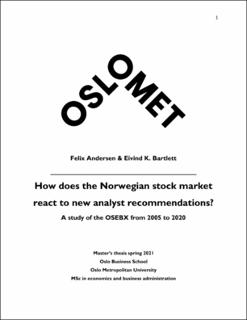| dc.description.abstract | In this thesis, we have gathered and analyzed 27,669 stock recommendations on 162
different companies, issued by 44 different brokerage firms. The data analyzed is collected
from 01.01.2005 to 31.12.2020, and the companies studied are the ones that have been,
either briefly or throughout the whole period, part of the OSEBX index. Two event windows are
applied to study both the immediate reaction and the pre- and post-event reactions. The
research question we intend to answer is:
“How does the Norwegian stock market react to new analyst recommendations?:
A study of the OSEBX from 2005 to 2020”.
To measure the market reaction to the recommendations, we applied the guidelines presented
in MacKinlay (1997). In the three-day event window, we find that the average cumulative
abnormal return (ACAR) for buy, hold, and sell recommendations are 0.548%, -0.542%, and
-1.060%. Hold recommendations are considered negative rather than neutral. In the 11-day
event window, we find that the ACAR is positive for buy recommendations in the days before
the event. However, it is negative for hold and sell recommendations, indicating a trend for the
stocks before the recommendation.
Examining trading volume, we find it abnormally high in the days surrounding the issuing of
the recommendation. We believe much of the increase in volume before the recommendation
is caused by other events. For downgrades to sell recommendations, we believe the
recommendations are the main reason for the increased volume we observe. We also
explore if the number of recommendations a brokerage firm has issued during the 15 years,
affects the ACAR. We find that DNB Markets, being the most frequent issuer of stock
recommendations for the OSEBX, is the brokerage firm with the highest ACAR for both buy
and sell recommendations. We believe there is a causal effect between DNB Markets issuing
a sell recommendation and the stock yielding a negative ACAR.
Lastly, we conduct a regression analysis to distinguish some of the variables that affect the
ACAR from a recommendation. The regression confirms that DNB Markets have a larger
influence on the market than other brokerage firms. Furthermore, it shows that
recommendation changes are more influential than reiterations, that a target price further
away from the mean is more likely to be influential, and that a larger number of hold or sell
recommendations issued on the same stock on the same day enhances the effect on the
ACAR. However, the model has low explanatory power, leading us to believe more factors
affect the stock price movements. | en_US |
